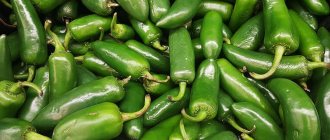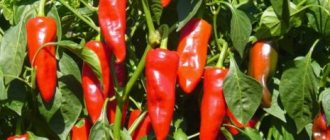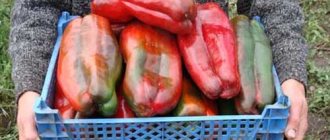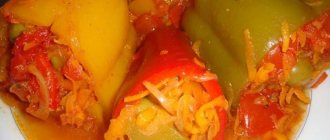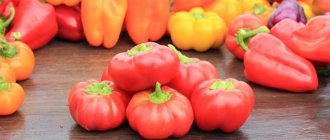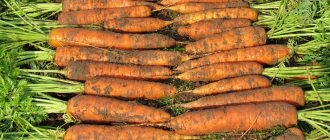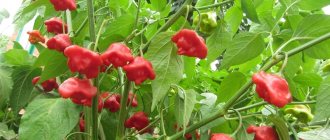The jalapeño is native to Mexico. The inhabitants of this country are known for their love of spicy dishes. In our latitudes, sweet peppers, such as bell peppers, are more often used. But still, spicy varieties have fans. Jalapeño peppers are grown in greenhouses and at home. In apartments it bears less fruit. But it looks very organic in a pot on the kitchen windowsill, also performing a decorative function.
General description of the plant
What is a Jalapeño pepper? The name of this pepper comes from the Mexican city of Jalapa. In national Mexican cuisine, not a single dish is complete without Jalapeño. Finely grated or chopped with a sharp knife, chili along with onions is an indispensable seasoning for every Mexican cafe.
Interesting! The plant grows up to 1 m in height. Productivity: 24-35 pods per bush. The length of the fruits reaches from 4 to 10 cm.
They are collected unripe - green. They acquire a red tint after drying or at the end of growth. If you do not have time to collect the pepper on time, the quality will deteriorate. The red Jalapeño is valued much worse than the green one. These peppers are exported to third world countries, buried in the ground, or carefully smoked to make chipotle seasoning.
Meet the jalapeño
My acquaintance with this Mexican hot pepper happened spontaneously. When I went to a garden store to buy bell pepper seeds, I noticed a bag labeled “Hot Jalapeño Pepper.”
I liked the fact that it can be grown as a potted crop. It makes no sense to plant a plant in a greenhouse: there is nowhere to put such a quantity of hot pepper. But to always have fresh pepper on hand, why not. I immediately remembered my childhood: my grandmother always had “Ogonyok” growing on her windowsill in the village; she would break off a piece of pepper directly from the bush and throw it into the soup.
Grandfather, thinking that she was sparing such a valuable seasoning at that time, tore off the whole fruit and, before grandmother had time to react, sent it into the pan. And then he ate the soup and praised how delicious it turned out. However, having finished off spoonfuls of the spicy dish, he said: “Praise, don’t praise, but you can’t eat this.”
These memories prompted me to buy a tempting packet of seeds. When I got home, I looked up information about jalapenos. It turned out that its green fruits are considered the most valuable: they are pickled, stuffed with cheese, fried and smoked. But red peppers are less valuable: they are dried and ground, and used as a seasoning.
Jalapeño is a medium hot pepper. It ranges from 2,500 to 8,000 on the Scoville heat scale.
Photo
The photo shows the Jalapeno pepper:
Home care
Seed preparation
Pepper grows easily in any climate.
Planting is done using sprouts or seeds. Seeds are bought only in gardening stores.
Before planting, they are soaked in a special mixture. To do this you will need potassium permanganate and a bandage.
The seeds are placed on moistened cotton wool and allowed to sit for 48-62 hours. Planting material must be stored in a warm, windless place. Avoid direct exposure to sunlight and drafts.
The cotton wool is covered with gauze. This procedure allows you to preserve the seeds in a greenhouse state. Also, do not allow the cotton pad to dry completely. The material must always be damp.
Required soil
Planting is done in the spring. March and April are best. This period is considered the most optimal for excellent plant germination.
The growth time of seedlings is 45-75 days. For planting, containers are prepared in advance. The soil is purchased ready-made.
The best soil is suitable for vegetable or flower crops. The soil must contain minerals and vitamins. You can also prepare the soil yourself. To do this you will need sand, peat, humus and soil.
Half the sand is mixed with peat, soil and humus are added. You can add a glass of ash to the resulting soil. The mixture is mixed and placed in seedling boxes.
Planting a plant with seeds
No more than 2-3 seeds are planted in one container.
It is necessary to take into account that there is space between them. You don't need to sow the seeds very deep.
A depth of 1-1.5 cm is ideal. The seeds are covered with a small amount of soil.
Immediately after planting, they are watered with a sprayer. Do not use a direct stream of water, as high pressure water can wash them away.
Important! If you sow seeds deeper than 1-1.5 cm, they will not be able to sprout and will rot in the soil.
Growing seedlings
Jalapeño peppers are very heat-loving. They do not like drafts and cold rooms. Avoid direct exposure to the sun. Otherwise, the seedlings will die.
Due to the heat-loving nature, the planting boxes are covered with glass or bags. It is important that such a coating allows light to pass through. Seedlings must be ventilated 3-4 times every 7 days.
Otherwise, the plant will suffocate and rot. After 3-4 leaves appear on each bush, the plant is planted in larger containers. In this case, weak, poorly developed processes are removed. It is necessary to water the seedlings moderately and regularly.
Transplantation into open soil
Seedlings are transplanted in late spring - early summer. May and June are good. When transplanting, it is necessary to leave small row spacing of 35-50 cm. When the pepper reaches a height of 10-20 cm, pinch out the growth point. In this case, the shoots must be left.
The optimal temperature for growing pepper is 26-33°C. Therefore, it is most advisable to organize a small greenhouse. With proper care, peppers bloom immediately after transplanting into the ground. Flowering continues until the end of summer. In place of the flowers, small fruits are formed.
Feeding and fertilizers
Feeding is carried out 3-4 times throughout the season.
Manure diluted with water works well. The ratio of this fertilizer is 1:10. You can use ash.
A glass of ash is mixed with a bucket of water. These mixtures are used to water the soil around the plant. Direct contact of manure with the plant itself and its roots should not be allowed.
Otherwise, a severe burn may occur and the plant will die. The special mixture “Stimul” is also perfect.
This drug is sold in specialized stores. It quickly heals plants from stress and restores the necessary vitality.
Watering
Watering should be regular and very abundant. Overdrying the earthen clod can cause flowers to fall off, which means a reduction in yield. But overwatering provokes the development of unwanted root rot. Optimal watering is 2-3 times a week. Use separated water. Do not use water with chemical impurities.
Processing of shoots and harvesting
When treating shoots, you can remove yellow leaves and bare branches. But it is not necessary to prune the plant.
Important! It takes 65-95 days to fully ripen.
Collection is carried out only with gloves. Contact with pepper causes burns and severe skin irritation. Fresh peppers are stored in jars in cellars or refrigerators. It can be left fresh for no more than 14 days. When dry, pepper is stored in a dark place in closed containers.
Breeding
"Jalapeño" is a perennial. Its winter dormancy period is very pronounced.
In this case, the bush must be kept in a greenhouse or indoors. The optimal temperature is 15-20°C. Temperatures should not be allowed to drop below 12°C.
During the growing season, the plant needs heat within 23-26°C. Propagation for seeds is carried out from January to March. The seeds are removed from the most beautiful and mature pods. They are dried in the open air for 2-3 hours. They are then suitable for planting and growing seedlings.
Benefits and harms
Pepper is rich in vitamins: A, B2, B6, C. It contains natural essential oils.
Pepper contains minerals. It is widely used in cooking. Jalapeño tinctures have beneficial properties. Pepper perfectly stimulates the growth of nails and hair.
It is useful for diabetes, sleep disorders, and depression. Jalapeño contains the beneficial substance alkaloid capsaicin, which lowers blood pressure.
The beneficial substances in pepper protect the body's cells from negative external influences and all kinds of toxins.
This type of pepper should be consumed carefully and in small quantities. Otherwise, you can severely burn the walls of your stomach. People with various diseases of the kidneys, stomach, liver and intestines should avoid Jalapeño. Children, pregnant and lactating women should reduce their consumption of pepper.
You can learn more about other types of chili peppers, including Cayenne, Habanero, Flame, and Bell peppers here.
Pepper uses
The most common use of jalapeno peppers is in cooking. In small quantities it is added to many dishes. Green fruits are chopped using a sharp knife or a fine grater and added to sauces, first courses, stews, meat and fish. The jalapeño pepper is not as hot as the more familiar chili, but it is still quite hot. And heat treatment does not deprive it of its properties. In Mexican cuisine, it is included in more than 90% of recipes. Red overripe fruits are dried, ground and become an independent spice or seasoning component.
In medicine, the jalapeno pepper has also found its niche. Its pulp, and even more so its grains, have a warming property. A large amount of the substance in contact with the skin can cause irritation, even burns. But in moderation, fruit powder is added to ointments for joints and lower back. When applied regularly, pepper tincture stimulates hair and nail growth. There are cases when, with the help of this plant, people partially relieved their headaches, or even completely got rid of migraines. Eating a small amount of pepper every day, or even simply smearing it on the nostrils, helped in healing.
Among other things, jalapeno can act as a component of self-defense means, such as pepper spray and the like.
Jalapeno fruits are less hot than chili peppers
Diseases and pests
Due to the pungency of the fruit, the plant is not susceptible to pests. When growing a plant at home, spider mites may appear. It is washed off with water and the pepper leaves are wiped with damp cotton wool.
Gardeners love the Jalapeño pepper for its unpretentious cultivation. The plant is thermophilic. Responds well to fertilizing and fertilizers. The fruits are very beneficial for the human body and contain essential vitamins.
If you find an error, please select a piece of text and press Ctrl+Enter.
Planting jalapeños
Growing jalapenos in open ground is possible, but it is easier to observe agrotechnical features in an apartment. To plant jalapenos you will need cuttings or seeds. Jalapeño cuttings are not very common due to the low survival rate of cuttings. Before planting, disinfect jalapeño seeds and leave them in a 1% manganese solution for 1 day. Prepare fertile soil from organic fertilizers, garden soil and sand (2:2:1), do not forget about drainage from large particles (broken bricks, gravel, pieces of tiles).
Source

